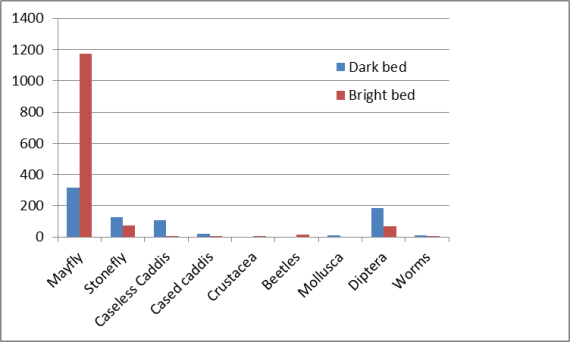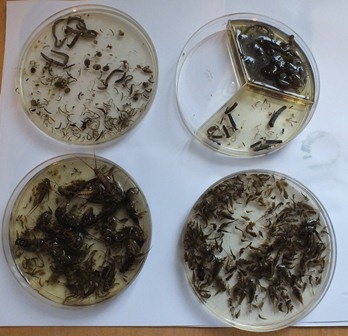After two and a bit days I finally managed to sort, identify and count the invertebrates samples from the bright and dark riverbed sites in the lower river at the Brae Water. On Friday I finished sorting the sample from the bright riverbed before spending all day counting and identifying. That was a real marathon as I counted 1172 mayfly nymphs, 1130 of which belonged to the Rhithrogena genus of which there are two families in the UK. The vast majority of the nymphs were relatively small and were probably Oive Uprights (not Medium Olives as I stated last week), with the remainder March Browns. The remaining mayflies consisted of 40 Baetids (Large Dark Olives etc) and 2 Heptagenia (Yellow May Dun). I counted 1342 invertebrates in total from that sample so it was dominated by Rhithrogena nymphs forming 86% of the total.
The bright riverbed consisted of relatively mobile small cobbles with a fast current. The Rhithrogena nymphs are highly adapted to life in the fast flow, even their gills are structured to enhanced its ability to cling to rocks in currents that would sweep less well adapted invertebrates away. “An Anglers Emtomology” by J.R. Harris (1952) contains a superb line drawing of the underside of a Rhithrogena nymph showing the strucure of the gills. I have taken the liberty of copying and showing the drawing here.

Rhithrogena nymph, note the Latin name of the March Brown has now changed.
This type of mayfly are commonly known as flattened mayflies as the body profile is also suited to life in fast flowing water. Flattened mayflies are well adapted to fast flowing, mobile riverbeds; habitat that is abundant in the Spey catchment.
As noted in the blog post last week the invertebrate sample from the dark riverbed appeared at first glance to be quite different. The indentification and counting proved this to be the case. There was lower overall abundance of invertebrates in the dark bed site (774 in total) but the range and diversity of species present were greater.

Comparison between dark and bright riverbed invertebrate samples
In the dark riverbed site there was an even split of mayflies between the baetid and flattened types, reflecting the slower current and greater suitablity for a range of species. Caddis; caseless and cased, and stonefly were much more abundant in the dark riverbed site, as were diptera (midge larvae etc).

Dark riverbed sample sorted ready for identification and counting. Clockwise from top left: diptera, molluscs and miscellaneous, caddis:caseless and cased, mayflies, and stoneflies
In Ayrshire we developed a scoring system for invertebrate samples based on the Riverfly Partnership approach http://www.riverflies.org/. Applying that scoring system to these samples found that both scored A1, the highest score, indicative of high abundance and quality. I will provide more details of that scoring system when I get a chance but the scores range from A1 (highest quality and high abundance) to D6, (low quality and abundance). I would expect most of the Spey mainstem to score highly using that system with more variation in the tributaries. Hopefully this year we will be able carry our invertebrate sampling at many of our electrofishing sites.
This was an interesting little exercise. The detailed work of counting and identification provided a good opportunity for me to learn which species are present in the Spey mainstem. It also highlighted the importance of the bright coloured section of riverbed for mayfly production. If you are a trout fisher you will know that the best hatches of March Browns generally occur downstream of fast riffles, although on the Spey they appear to be everywhere. This may only have been two samples but it highlights that far from being lifeless these fast flowing, mobile and bright areas of riverbed support a high density of invertebrates. When I looked at the invertebrate records supplied by SEPA the highest count of Rhithrogena in any sample was about 400. They probably didn’t sample exclusively in the same sort of riverbed as I did but it looks as if there will be a good olive hatch this spring/summer.
Spey Fishery Board





